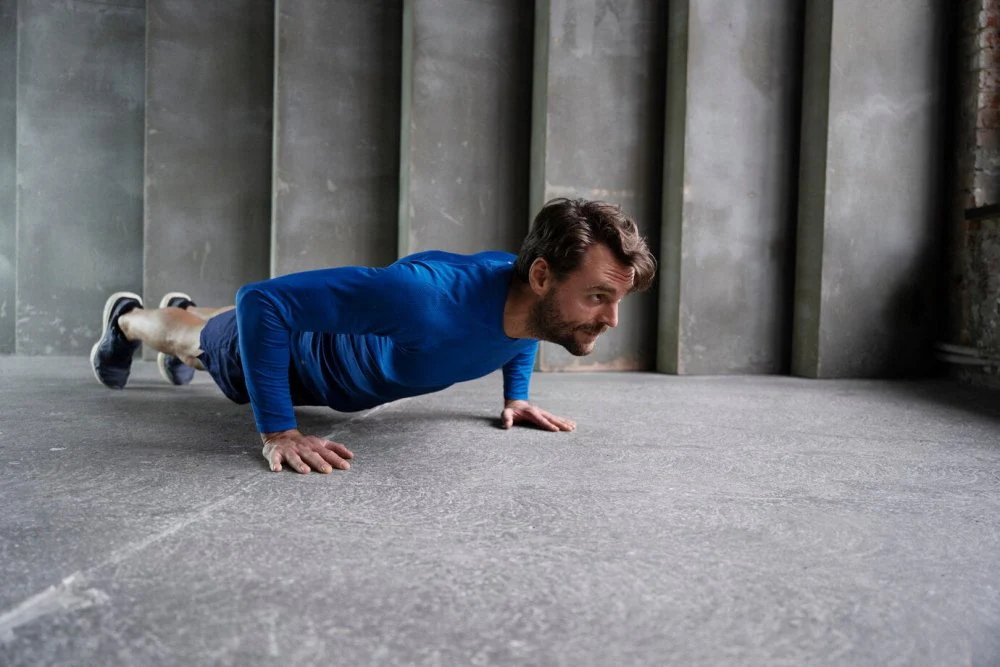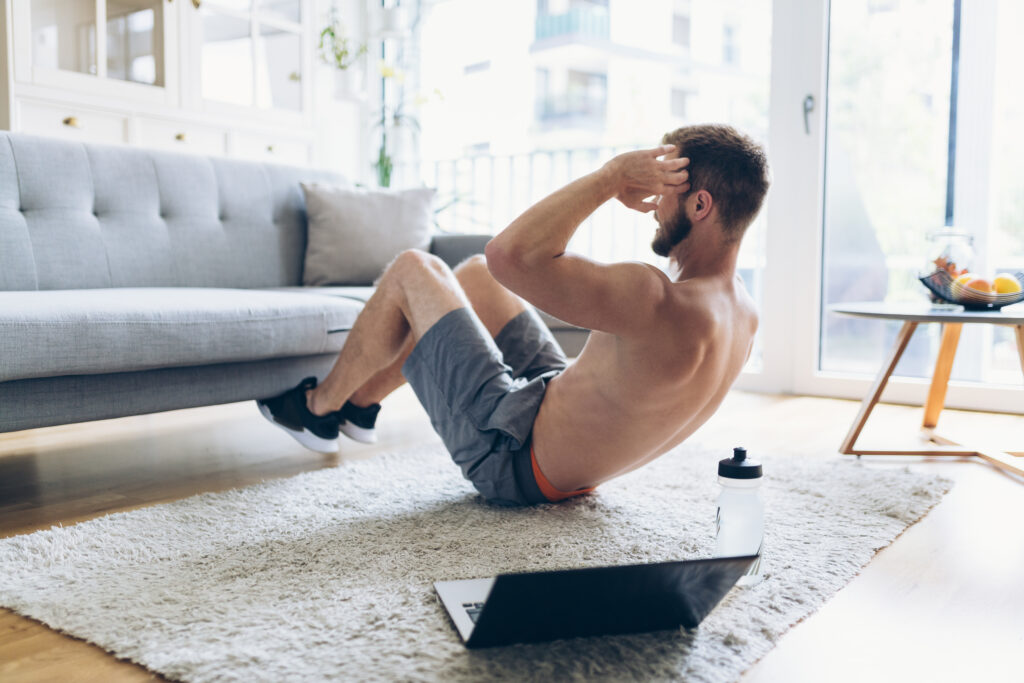Living in a cramped apartment, dorm room, or simply lacking space for a home gym doesn’t mean you have to sacrifice your fitness goals. The truth is, some of the most effective workouts require nothing more than your body weight and a few square feet of floor space.
Whether you’re traveling, working from a tiny studio, or just prefer the convenience of equipment-free workouts, bodyweight exercises offer a complete fitness solution that can transform your strength, endurance, and overall health—all within the comfort of your small space.
Why Bodyweight Exercises Are Perfect for Small Spaces
Space Efficiency: Most bodyweight exercises require just 6-8 feet of floor space—about the size of a yoga mat. You can literally work out in your bedroom, living room, or even a hotel room.
No Equipment Investment: Save hundreds of dollars on gym equipment and memberships. Your body provides all the resistance you need for an effective workout.
Functional Strength: Unlike machines that isolate muscles, bodyweight exercises train multiple muscle groups simultaneously, improving real-world movement patterns and coordination.
Scalable Difficulty: From beginner-friendly modifications to advanced variations, bodyweight exercises can challenge anyone regardless of fitness level.
Essential Bodyweight Exercises for Every Muscle Group
Upper Body Powerhouse Moves
Push-Ups (and Variations) The classic push-up remains one of the most effective upper body exercises. Start with standard push-ups, targeting your chest, shoulders, and triceps.
Beginner modification: Perform push-ups against a wall or on your knees Advanced variation: Try diamond push-ups, decline push-ups with feet elevated, or single-arm push-ups
Pike Push-Ups Transform your push-up into a shoulder-building machine. Start in a downward dog position and lower your head toward your hands, then push back up. This targets your shoulders and upper chest while building functional overhead strength.
Tricep Dips Use a sturdy chair, couch edge, or even the floor. Tricep dips isolate the back of your arms while also engaging your core for stability.
Lower Body Strength Builders
Bodyweight Squats The foundation of lower body strength, squats work your glutes, quadriceps, hamstrings, and core. Focus on sitting back as if reaching for a chair, keeping your chest up and knees tracking over your toes.
Progression: Single-leg pistol squats, jump squats, or Bulgarian split squats using a chair
Lunges in Every Direction Forward lunges, reverse lunges, and lateral lunges target different muscle groups and movement patterns. These unilateral exercises also improve balance and address muscle imbalances.
Single-Leg Glute Bridges Lie on your back and lift your hips while balancing on one leg. This exercise targets your glutes and hamstrings while challenging your core stability.
Wall Sits Find any wall and slide down into a sitting position. Hold for 30-60 seconds to build muscular endurance in your legs while requiring zero floor space.
Core and Full-Body Integration
Plank Variations The plank family offers endless possibilities: standard planks, side planks, plank-to-push-up transitions, and plank with leg lifts. These exercises build core strength while improving posture and stability.
Mountain Climbers Combining cardio with core strengthening, mountain climbers get your heart rate up while targeting your abs, shoulders, and legs in a small space.
Burpees The ultimate full-body exercise that combines a squat, plank, push-up, and jump. Burpees work every major muscle group while providing intense cardiovascular benefits.
Bear Crawls Move forward and backward on your hands and feet (knees off the ground) to engage your entire body while improving coordination and mobility.

Creating Effective Small Space Workouts
The 20-Minute Full-Body Circuit
Perform each exercise for 45 seconds, followed by 15 seconds of rest:
- Bodyweight squats
- Push-ups
- Mountain climbers
- Lunges (alternating legs)
- Plank hold
- Tricep dips
- High knees in place
- Glute bridges
Complete 2-3 rounds with 1-2 minutes rest between rounds.
The Tabata Intensity Blast (12 minutes)
Choose 3 exercises and perform each in a Tabata format (20 seconds work, 10 seconds rest, 8 rounds total):
Round 1: Burpees Round 2: Bodyweight squats Round 3: Push-ups
This high-intensity format maximizes results in minimal time and space.
The Strength and Mobility Flow (25 minutes)
Combine strength exercises with mobility work:
- Warm-up: Arm circles, leg swings, hip circles (3 minutes)
- Strength circuit: 4 exercises x 3 sets (15 minutes)
- Cool-down: Stretching and yoga poses (7 minutes)
Maximizing Your Small Space Setup
Clear Your Workout Zone: Remove furniture, breakable items, and obstacles. You need about 6×6 feet of clear space for most routines.
Use Vertical Space: Exercises like jumping jacks, high knees, and jump squats require ceiling clearance. Measure your space to avoid accidents.
Non-Slip Surface: Use a yoga mat, towel, or ensure your flooring provides adequate grip to prevent slipping during exercises.
Noise Consideration: Choose low-impact variations for apartment living. Replace jumping exercises with step-ups or marching in place.
Mirror Check: If possible, position yourself near a mirror to monitor your form and technique.
Progression and Variation Strategies
Increase Time Under Tension: Slow down your repetitions to make exercises more challenging without requiring more space or equipment.
Add Pause Reps: Hold the bottom position of squats, push-ups, or lunges for 2-3 seconds to increase difficulty.
Combine Exercises: Create compound movements like squat-to-overhead reach or lunge-with-twist to engage more muscles simultaneously.
Isometric Holds: Replace dynamic movements with static holds (wall sits, planks, single-leg stands) to build strength and endurance.
Common Mistakes to Avoid
Neglecting Warm-Up: Always spend 3-5 minutes warming up with light movement and dynamic stretches, even in small spaces.
Poor Form Over Speed: Focus on proper technique rather than rushing through repetitions. Quality trumps quantity every time.
Ignoring Recovery: Your muscles need rest to grow stronger. Allow 24-48 hours between intense sessions targeting the same muscle groups.
Workout Monotony: Vary your routines every 2-3 weeks to prevent plateaus and maintain motivation.

Sample Weekly Schedule for Small Space Training
Monday: Full-body strength circuit (30 minutes) Tuesday: Core and flexibility focus (20 minutes) Wednesday: Active recovery or rest Thursday: High-intensity interval training (20 minutes) Friday: Lower body emphasis (25 minutes) Saturday: Upper body and cardio combination (30 minutes) Sunday: Gentle yoga or stretching (15 minutes)
Making It Sustainable
Start Small: Begin with 10-15 minute sessions and gradually increase duration as your fitness improves.
Schedule Consistency: Choose the same time each day to build a sustainable habit.
Track Progress: Keep a simple log of exercises, repetitions, and how you feel to monitor improvement.
Celebrate Wins: Acknowledge every milestone, from completing your first full push-up to holding a plank for a full minute.
Conclusion
Your fitness journey doesn’t require a large space, expensive equipment, or gym membership. With bodyweight exercises, you have access to a complete fitness solution that can build strength, improve cardiovascular health, and enhance your overall well-being—all within the confines of your small space.
The key to success lies in consistency, progressive overload, and listening to your body. Start with the basics, master proper form, and gradually challenge yourself with more advanced variations.
Remember, the best workout is the one you’ll actually do. By removing barriers like space constraints and equipment needs, bodyweight exercises make fitness accessible anytime, anywhere. Your small space isn’t a limitation—it’s your personal training studio waiting to transform your health and fitness journey.
Start today with just 10 minutes, and discover how effective small space workouts can be. Your body—and your busy schedule—will thank you.
